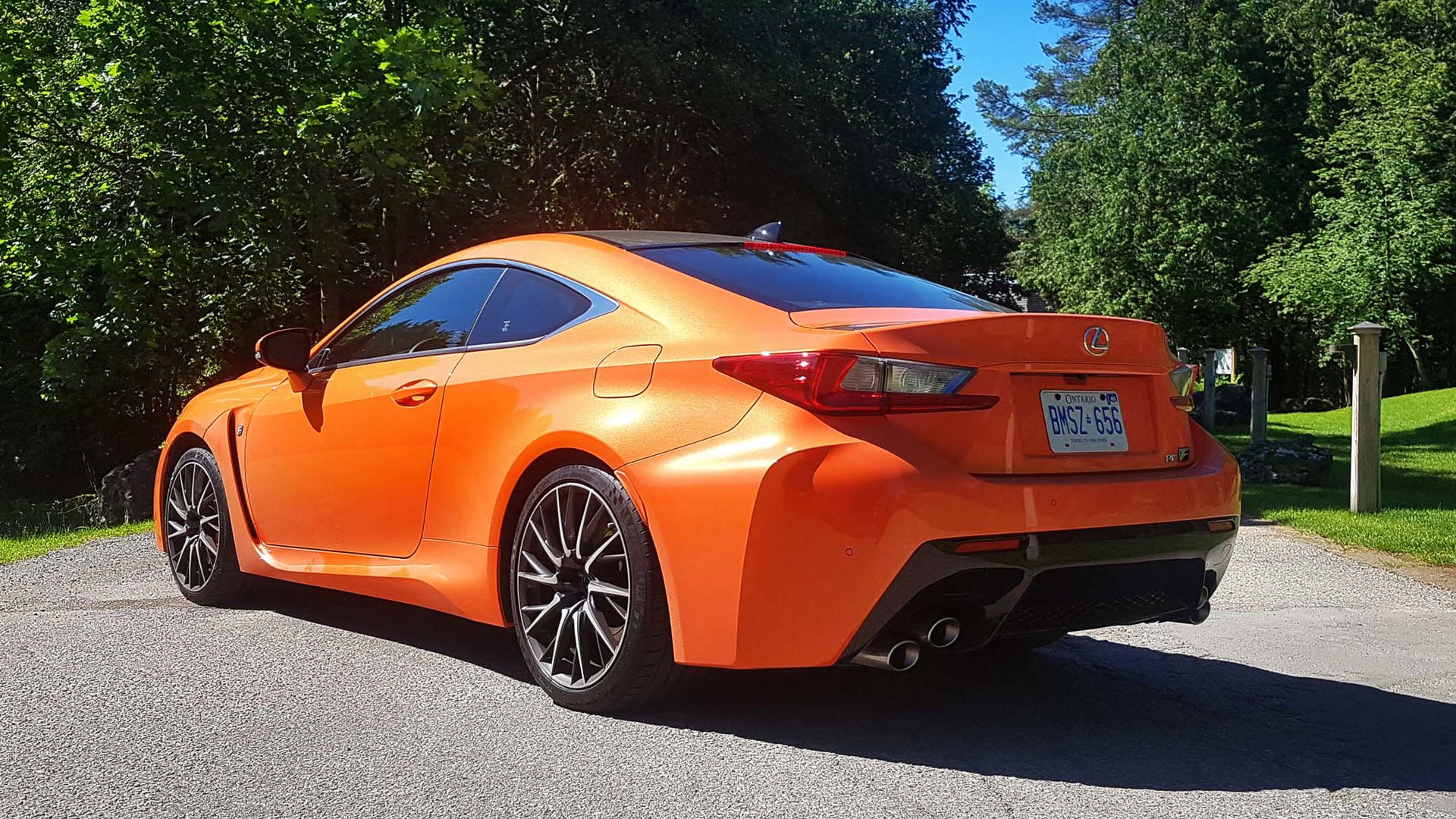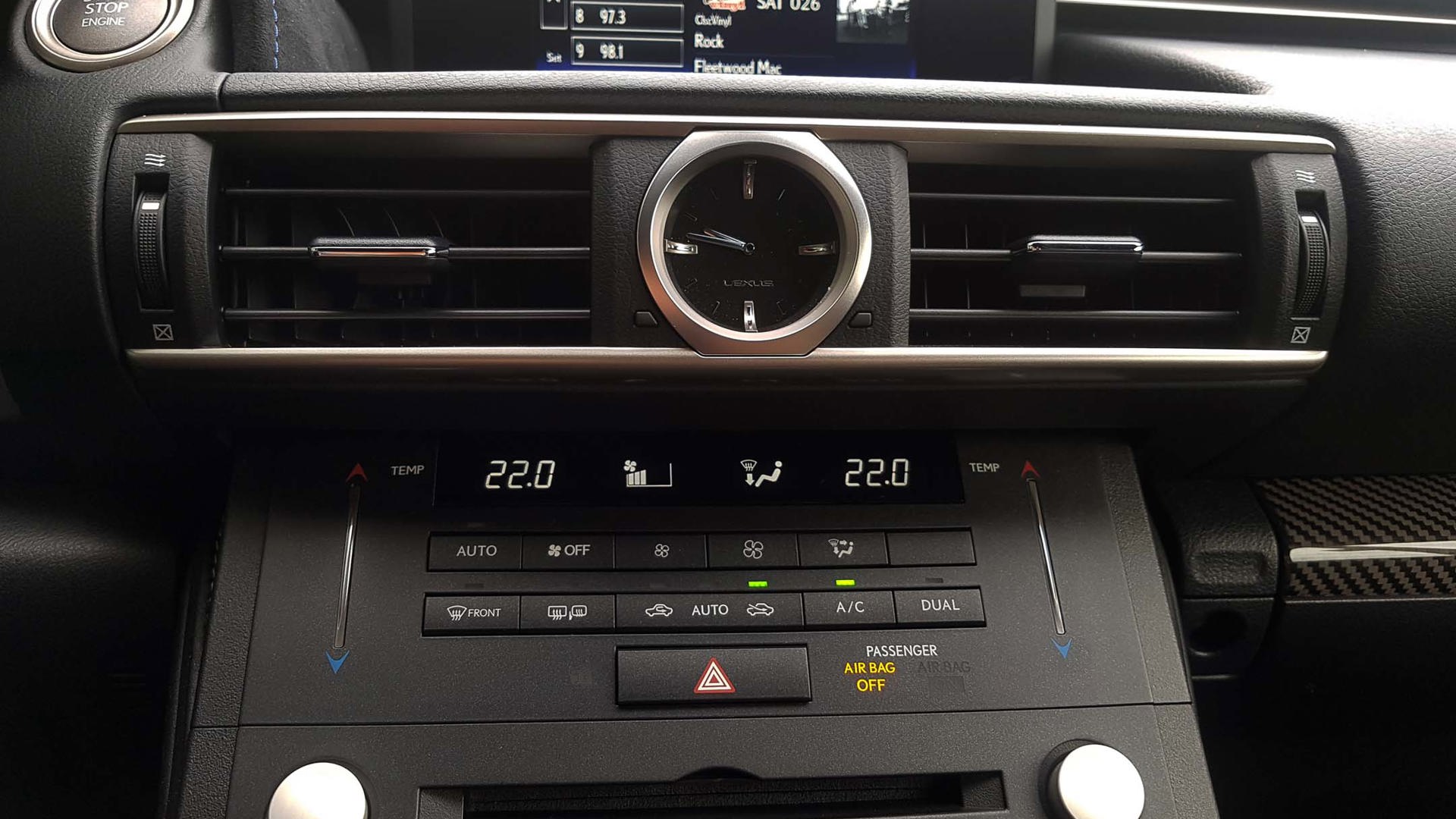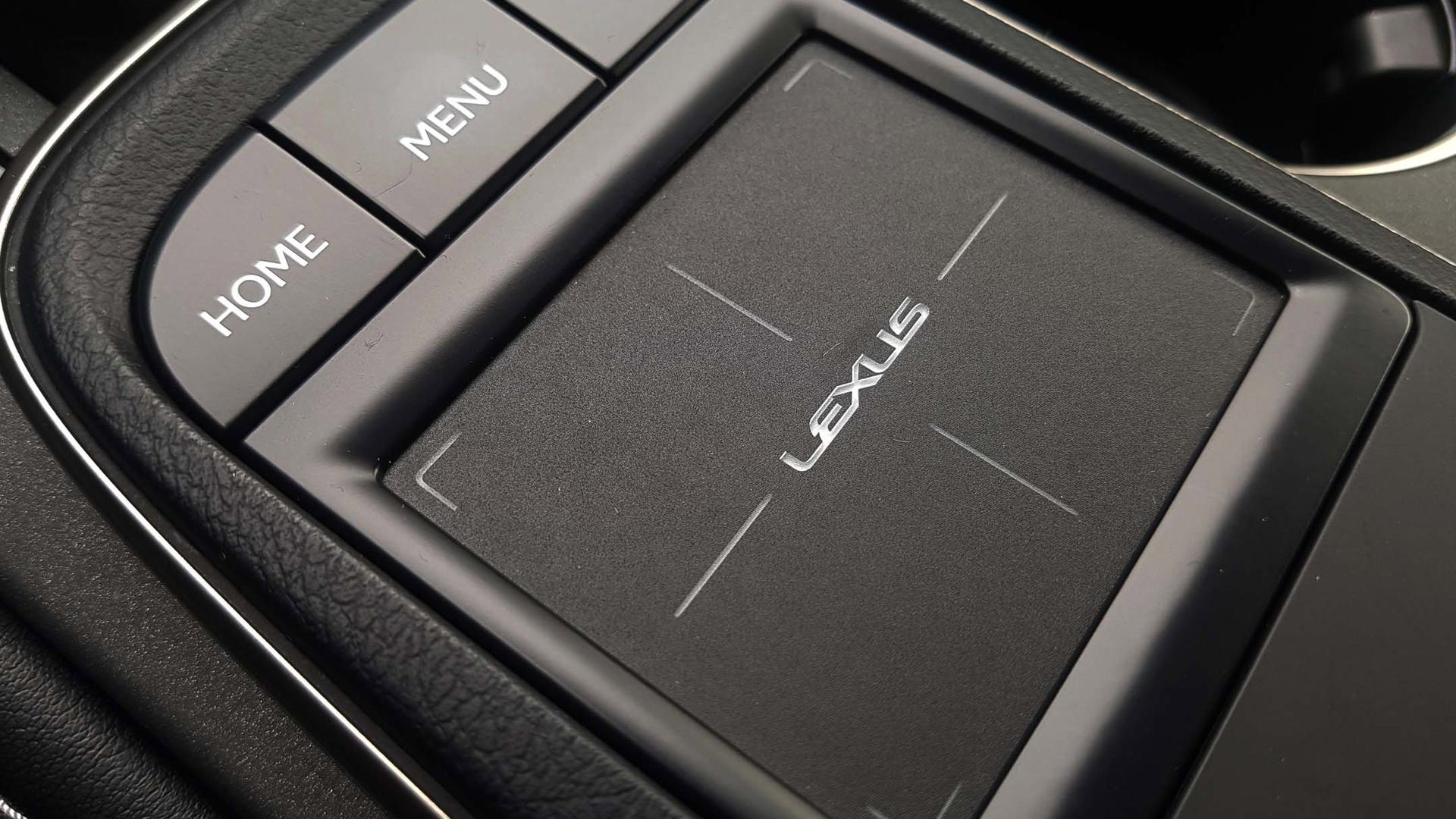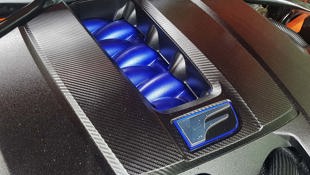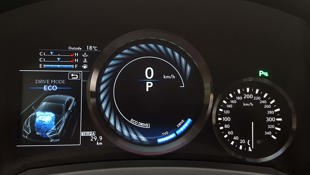 AutoTrader SCORE
AutoTrader SCORE
-
STYLING8/10
-
Safety8/10
-
PRACTICALITY7/10
-
USER-FRIENDLINESS7/10
-
FEATURES8/10
-
POWER9/10
-
COMFORT8/10
-
DRIVING FEEL8/10
-
FUEL ECONOMY7/10
-
VALUE7/10
A new annual tradition is forming for me, and it’s one I can get behind.
This 5.0-litre V8 makes 467 horsepower at 7,100 rpm and 389 lb-ft of torque at 4,800 rpm. You’ll almost never hit those figures within the constraints of the law, but hey, it sounds fabulous.
The deal: my best friend’s boyfriend sends her and me on an indulgent overnight girls’ getaway to celebrate her birthday. In return, it’s my job to secure a car worthy of the occasion.
It’s a hardship, I know.
Last year, bestie had her first convertible experience. This year, we went with a hard-top and headed for a resort via some of Ontario’s best roads in the 2017 Lexus RC F.
Amy swooned at first sight and declared this one of the hottest cars she’s ever seen for one reason alone: because it’s orange. (Technically, the colour is called Solar Flare.) She truly couldn’t have given a lick about one single other thing about it. So, there you have it, guys: you can buy any expensive car you want, but if it’s attention from the ladies that you seek, then get it in an unusual colour.
I’ll admit that I was rather taken by it, too, especially since it continued into the new-for-2017 available matching orange brake calipers.
An examination that goes deeper than the paint, though, reveals some ways in which the RC F is becoming a unicorn within its segment – and others where its three-year-old design is beginning to show signs of age.
One thing to note: the RC F is at its heart a track car, but this is in no way a track test. The scope of my time with it covered daily use and some spirited driving during a road trip for two on public roads. This review is therefore less about zero-to-60s and ’Ring times and more about what the RC F is like to live with on an ongoing basis.
Powertrain
The RC F has a single engine option, but it’s one that attracts purists since Lexus is increasingly alone in keeping naturally aspirated mills in its performance cars. This 5.0-litre V8 makes 467 horsepower at 7,100 rpm and 389 lb-ft of torque at 4,800 rpm. You’ll almost never hit those figures within the constraints of the law, but hey, it sounds fabulous. It also switches between fuel-efficient Atkinson cycle and thirstier Otto cycle operation, depending on how you’re driving it, to save you a bit of coin at the pumps.
And while its competitors shift toward offering all-wheel drive, Lexus continues to eschew it entirely for this model, playing to the same enthusiast base by offering rear-wheel drive only. It comes equipped with a limited-slip differential and an adaptive multi-link rear suspension with a stabilizer bar. This unit also has the optional torque-vectoring differential installed, which is part of the $7,700 Performance Package that includes the aforementioned painted calipers, a different set of 19-inch aluminum alloy wheels, the carbon-fibre roof and rear spoiler, and a power moonroof.
It’s a bit of an odd contrast, then, that in this car designed around the sticklers, the only transmission option is an eight-speed automatic. It’s a good one, mind you: Lexus calls it a sports direct-shift transmission, and it’s got a fair bit going for it. If you put it in manual mode, it’ll stay there permanently while you run through the gears via either the shifter or the paddles; if you let the car do the rowing for you, it can tell when you’re in a curve and will hold a lower gear to give you some seriously satisfying exit acceleration. Oh, and like it or not, it shifts faster than you ever could. Still, plenty of the people who would consider buying this car will find the lack of third pedal to be disconcerting.
On the fuel economy front, the RC F is not great for what it is, but it’s not bad. It’s well-behaved in highway cruising – the engine is running in Atkinson cycle at that point, and it hums along happily at 1,600 rpm at 100 km/h and 1,900 rpm at 120 km/h in normal drive mode – but adding in some spirited driving naturally brings its figures up quickly. On paper, the declared NRCan numbers come in at 15.2 L/100 km city, 9.5 highway, and 12.6 combined. I averaged 12.1 L/100 km in my week with it, which seems about right for a balance of 70/30 highway versus backroads.
Drive experience
How does all of this add up in the real-life driving experience? Well, it’s good fun. I got just enough bobbing and weaving time in on Forks of the Credit Road to appreciate the smooth hammering of the rev-matched downshifts and the torque-vectoring diff’s complete lack of understeer. I pulled away from the twisties with a satisfied grin. (At least, I enjoyed it to the extent that the road can still be enjoyed. Thanks, boy racers, for spooking the local residents, spurring them to push for traffic-calming bumps, and ruining it for everyone. To the RC F’s credit, though, its 13 cm ground clearance spared me the stress of scraping the body work on them.)
Is it all too much, though? This is a whole lot of car for the occasional rip. And for some types of drivers, it might even be a bit too perfect. The RC F does a fair amount of the work for you, and certain people may find it takes the spirit out of spirited in that sense. You can turn some of it off, of course, and between the four drive modes and three TVD settings, you’re bound to find a balance you like. But there’s a visceral hanging-on-by-the-seat-of-your-pants feeling some folks crave that you need to work awfully hard to find here. Whether that’s a bad thing is entirely up to you.
Design
Lexus’s design language is polarizing, but I’m a fan. There are a lot of small details, which can look overworked on some cars, but on the RC F especially I feel that they all nip and tuck in just the right places. From the chrome window accent to the subtle shoulder line and stacked quad exhaust, it all works for me. The worst thing Lexus did for the RC F’s styling was to offer an even more beautiful car when they released the LC 500 earlier this year.
Inside, things get a little less exciting, although the carbon-fibre and Alcantara accents are a nice touch. The sport seats are extremely comfortable, and while there’s a lot going on in the centre stack, everything is laid out such that you don’t trip over yourself or your cup holders. With us two average-height women in the front seats, there was enough room for my daughter to sit behind one of us in the back, though only just. Taller people won’t have as much luck.
Another major plus in the livability department is the size of the trunk, which feels relatively spacious for this class of vehicle at 287 L. Our overnight bags were practically swimming in it. You can attract a girl with the RC F’s paint, marry her, and then take her for Costco runs. If she’s short and you can fit a kid in the back, she’ll have no excuse for making you sell it.
Connectivity
This is Lexus’s Achilles’ heel.
You’ve heard a lot by now about these smartphone apps that integrate with infotainment systems and do things like read your text messages out to you and navigate with real-time traffic info. Well, Toyota is working on a separate app platform, so its subsidiaries remain among the final hold-outs. That means that where Lexus is concerned, Apple CarPlay and Android Auto are out. You’ll have to just shove your phone into a storage bin and keep it there if you want to avoid distraction.
The system we’re left with, then, is the less user-friendly Toyota design. Most inputs are through the touchpad, which is finicky and requires too much attention while driving, and the tuning dial at the far right is a reach for me. I love flipping through stations and enjoying a variety of music while I’m driving, but in this car I tend to park it on a station and stay put because surfing is too much bother. For me, it takes away from the experience.
The dashboard-mounted screen is of a lower resolution than where much of the market has gone. This becomes especially noticeable with the back-up camera, which is grainier and harder to decipher than average.
Safety
Toyota has gone from lagging in the included safety features department to being an industry leader within the span of a year. More and more of their vehicles have a suite of technology features included as standard that are expensive add-ons with other brands.
On the RC F, the Lexus Safety System Plus is standard and includes a pre-collision system, lane-departure alert, automatic high-beams, and radar cruise control. This is on top of the blind-spot monitoring and rear cross-traffic alert systems that are wrapped into the base price.
The only downside is that I find the head-on collision warning to be overly enthusiastic – if you approach opposing traffic in a curve and the car reads it the wrong way, the alarm will make you jump out of your skin. Unfortunately, this leads to some drivers turning the system off. Dialling it back a touch would achieve the same purpose and make the system more universally useful.
Verdict
In a nutshell, if your idea of a spirited drive is more the do-it-yourself type, you may be better off shopping elsewhere. But if you want a car with a bottomless bag of technology tricks under the floor that will make you look like a better driver than you really are, look this one up.
And if you’re single, don’t forget to order it in orange.
| Engine Displacement | 5.0L |
|---|---|
| Engine Cylinders | V8 |
| Peak Horsepower | 467 hp @ 7,100 rpm |
| Peak Torque | 389 lb-ft @ 4,800 rpm |
| Fuel Economy | 15.2/9.5/12.6 L/100 km city/hwy/cmb |
| Cargo Space | 287 L |
| Model Tested | 2017 Lexus RC F |
| Base Price | $85,000 |
| A/C Tax | $100 |
| Destination Fee | $2,045 |
| Price as Tested | $94,845 |
|
Optional Equipment
$7,700 – Performance Package (torque vectoring differential, unique 19" alloy wheels, painted brake calipers, carbon fibre roof and rear spoiler, power moonroof) $7,700
|
|
